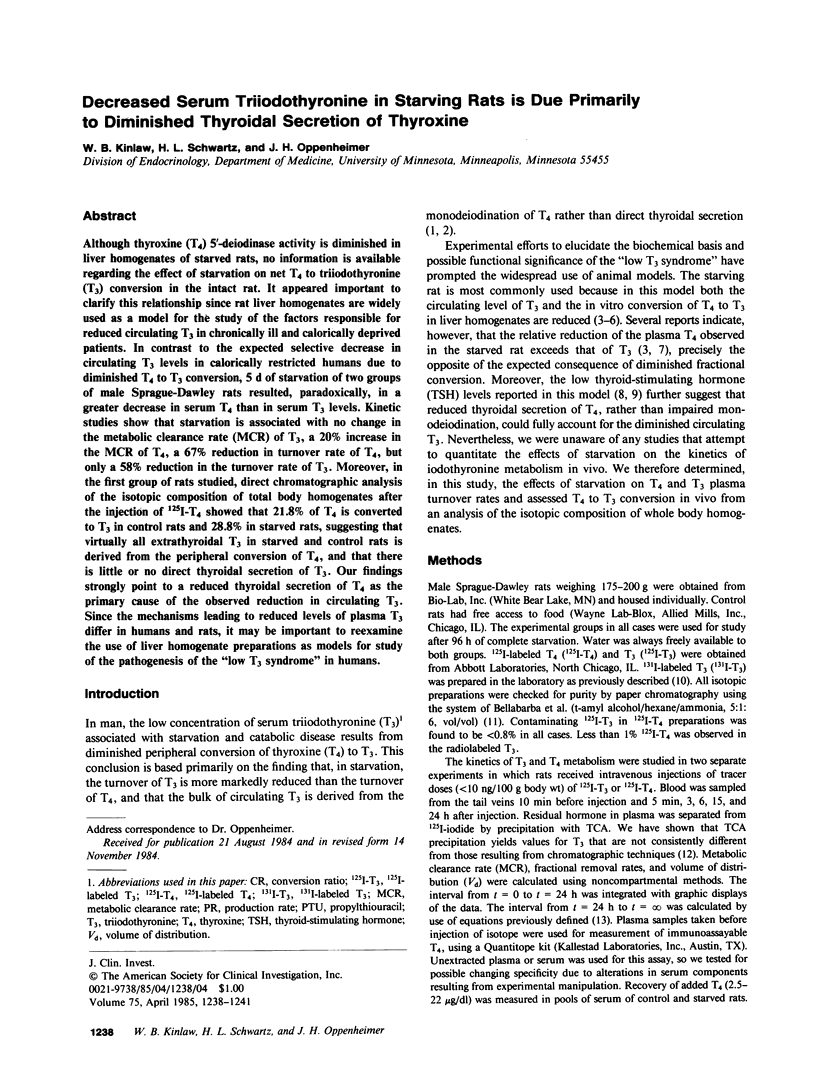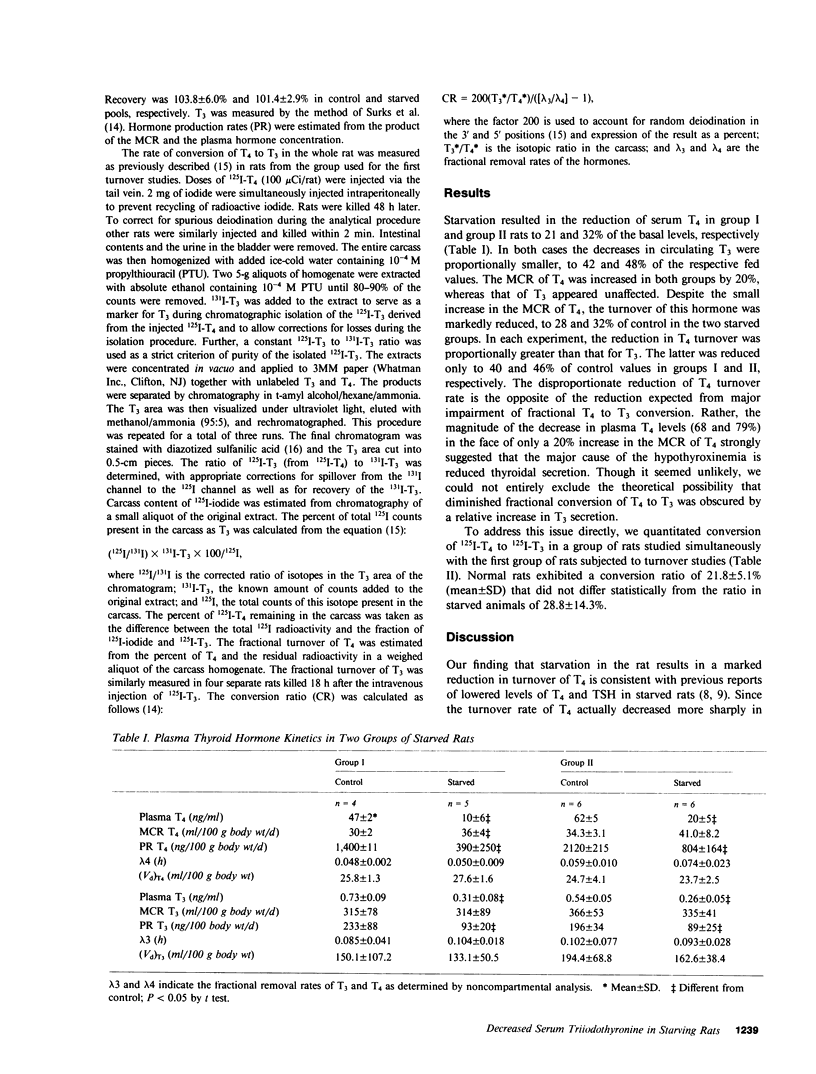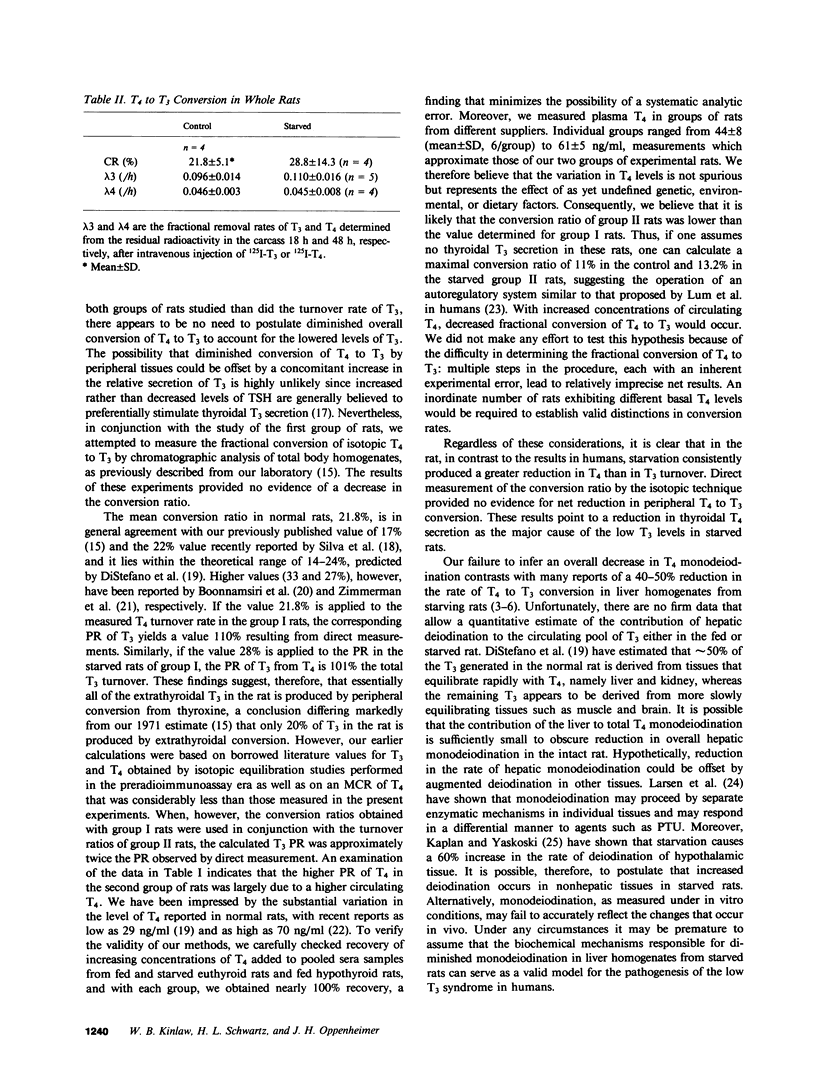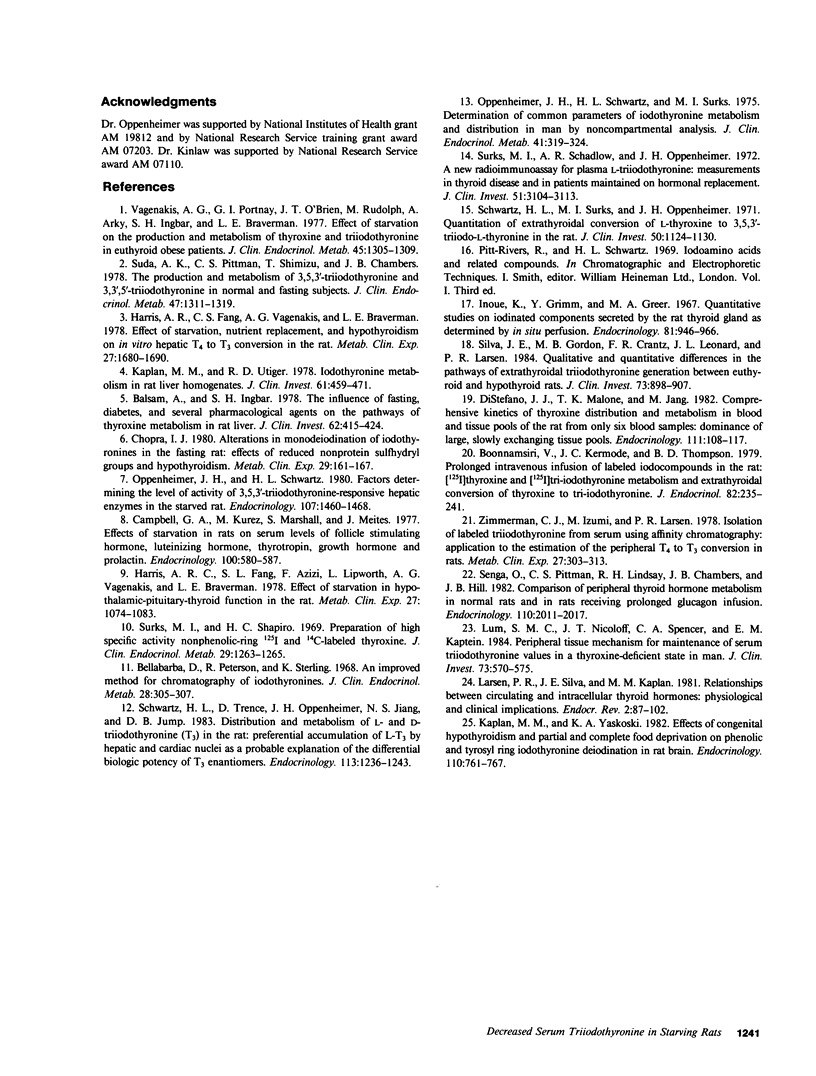Abstract
Although thyroxine (T4) 5'-deiodinase activity is diminished in liver homogenates of starved rats, no information is available regarding the effect of starvation on net T4 to triiodothyronine (T3) conversion in the intact rat. It appeared important to clarify this relationship since rat liver homogenates are widely used as a model for the study of the factors responsible for reduced circulating T3 in chronically ill and calorically deprived patients. In contrast to the expected selective decrease in circulating T3 levels in calorically restricted humans due to diminished T4 to T3 conversion, 5 d of starvation of two groups of male Sprague-Dawley rats resulted, paradoxically, in a greater decrease in serum T4 than in serum T3 levels. Kinetic studies show that starvation is associated with no change in the metabolic clearance rate (MCR) of T3, a 20% increase in the MCR of T4, a 67% reduction in turnover rate of T4, but only a 58% reduction in the turnover rate of T3. Moreover, in the first group of rats studied, direct chromatographic analysis of the isotopic composition of total body homogenates after the injection of 125I-T4 showed that 21.8% of T4 is converted to T3 in control rats and 28.8% in starved rats, suggesting that virtually all extrathyroidal T3 in starved and control rats is derived from the peripheral conversion of T4, and that there is little or no direct thyroidal secretion of T3. Our findings strongly point to a reduced thyroidal secretion of T4 as the primary cause of the observed reduction in circulating T3. Since the mechanisms leading to reduced levels of plasma T3 differ in humans and rats, it may be important to reexamine the use of liver homogenate preparations as models for study of the pathogenesis of the "low T3 syndrome" in humans.
Full text
PDF



Selected References
These references are in PubMed. This may not be the complete list of references from this article.
- Balsam A., Ingbar S. H. The influence of fasting, diabetes, and several pharmacological agents on the pathways of thyroxine metabolism in rat liver. J Clin Invest. 1978 Aug;62(2):415–424. doi: 10.1172/JCI109143. [DOI] [PMC free article] [PubMed] [Google Scholar]
- Bellabarba D., Peterson R. E., Sterling K. An improved method for chromatography of iodothyronines. J Clin Endocrinol Metab. 1968 Feb;28(2):305–307. doi: 10.1210/jcem-28-2-305. [DOI] [PubMed] [Google Scholar]
- Boonnamsiri V., Kermode J. C., Thompson B. D. Prolonged intravenous infusion of labelled iodocompounds in the rat: [125I]thyroxine and [125I]tri-iodothyronine metabolism and extrathyroidal conversion of thyroxine to tri-iodothyronine. J Endocrinol. 1979 Aug;82(2):235–241. doi: 10.1677/joe.0.0820235. [DOI] [PubMed] [Google Scholar]
- Campbell G. A., Kurcz M., Marshall S., Meites J. Effects of starvation in rats on serum levels of follicle stimulating hormone, luteinizing hormone, thyrotropin, growth hormone and prolactin; response to LH-releasing hormone and thyrotropin-releasing hormone. Endocrinology. 1977 Feb;100(2):580–587. doi: 10.1210/endo-100-2-580. [DOI] [PubMed] [Google Scholar]
- Chopra I. J. Alterations in monodeiodination of iodothyronines in the fasting rat: effects of reduced nonprotein sulfhydryl groups and hypothyroidism. Metabolism. 1980 Feb;29(2):161–167. doi: 10.1016/0026-0495(80)90141-9. [DOI] [PubMed] [Google Scholar]
- DiStefano J. J., 3rd, Malone T. K., Jang M. Comprehensive kinetics of thyroxine distribution and metabolism in blood and tissue pools of the rat from only six blood samples: dominance of large, slowly exchanging tissue pools. Endocrinology. 1982 Jul;111(1):108–117. doi: 10.1210/endo-111-1-108. [DOI] [PubMed] [Google Scholar]
- Harris A. R., Fang S. L., Azizi F., Lipworth L., Vagenakis A. G., Barverman L. E. Effect of starvation on hypothalamic-pituitary-thyroid function in the rat. Metabolism. 1978 Sep;27(9):1074–1083. doi: 10.1016/0026-0495(78)90153-1. [DOI] [PubMed] [Google Scholar]
- Harris A. R., Fang S. L., Vagenakis A. G., Braverman L. E. Effect of starvation, nutriment replacement, and hypothyroidism on in vitro hepatic T4 to T3 conversion in the rat. Metabolism. 1978 Nov;27(11):1680–1690. doi: 10.1016/0026-0495(78)90290-1. [DOI] [PubMed] [Google Scholar]
- Inoue K., Grimm Y., Greer M. A. Quantitative studies on the iodinated components secreted by the rat thyroid gland as determined by in situ perfusion. Endocrinology. 1967 Nov;81(5):946–964. doi: 10.1210/endo-81-5-946. [DOI] [PubMed] [Google Scholar]
- Kaplan M. M., Utiger R. D. Iodothyronine metabolism in rat liver homogenates. J Clin Invest. 1978 Feb;61(2):459–471. doi: 10.1172/JCI108957. [DOI] [PMC free article] [PubMed] [Google Scholar]
- Kaplan M. M., Yaskoski K. A. Effects of congenital hypothyroidism and partial and complete food deprivation on phenolic and tyrosyl ring iodothyronine deiodination in rat brain. Endocrinology. 1982 Mar;110(3):761–767. doi: 10.1210/endo-110-3-761. [DOI] [PubMed] [Google Scholar]
- Larsen P. R., Silva J. E., Kaplan M. M. Relationships between circulating and intracellular thyroid hormones: physiological and clinical implications. Endocr Rev. 1981 Winter;2(1):87–102. doi: 10.1210/edrv-2-1-87. [DOI] [PubMed] [Google Scholar]
- Lum S. M., Nicoloff J. T., Spencer C. A., Kaptein E. M. Peripheral tissue mechanism for maintenance of serum triiodothyronine values in a thyroxine-deficient state in man. J Clin Invest. 1984 Feb;73(2):570–575. doi: 10.1172/JCI111245. [DOI] [PMC free article] [PubMed] [Google Scholar]
- Oppenheimer J. H., Schwartz H. L. Factors determining the level of activity of 3,5,3'-triiodothyronine-responsive hepatic enzymes in the starved rat. Endocrinology. 1980 Nov;107(5):1460–1468. doi: 10.1210/endo-107-5-1460. [DOI] [PubMed] [Google Scholar]
- Oppenheimer J. H., Schwartz H. L., Surks M. I. Determination of common parameters fo iodothyronine metabolism and distribution in man by noncompartmental analysis. J Clin Endocrinol Metab. 1975 Aug;41(2):319–324. doi: 10.1210/jcem-41-2-319. [DOI] [PubMed] [Google Scholar]
- Schwartz H. L., Surks M. I., Oppenheimer J. H. Quantitation of extrathyroidal conversion of L-thyroxine to 3,5,3'-triiodo-L-thyronine in the rat. J Clin Invest. 1971 May;50(5):1124–1130. doi: 10.1172/JCI106584. [DOI] [PMC free article] [PubMed] [Google Scholar]
- Schwartz H. L., Trence D., Oppenheimer J. H., Jiang N. S., Jump D. B. Distribution and metabolism of L- and D-triiodothyronine (T3) in the rat: preferential accumulation of L-T3 by hepatic and cardiac nuclei as a probable explanation of the differential biological potency of T3 enantiomers. Endocrinology. 1983 Oct;113(4):1236–1243. doi: 10.1210/endo-113-4-1236. [DOI] [PubMed] [Google Scholar]
- Senga O., Pittman C. S., Lindsay R. H., Chambers J. B., Jr, Hill J. B., Jr Comparison of peripheral thyroid hormone metabolism in normal rats and in rats receiving prolonged glucagon infusion. Endocrinology. 1982 Jun;110(6):2011–2017. doi: 10.1210/endo-110-6-2011. [DOI] [PubMed] [Google Scholar]
- Silva J. E., Gordon M. B., Crantz F. R., Leonard J. L., Larsen P. R. Qualitative and quantitative differences in the pathways of extrathyroidal triiodothyronine generation between euthyroid and hypothyroid rats. J Clin Invest. 1984 Apr;73(4):898–907. doi: 10.1172/JCI111313. [DOI] [PMC free article] [PubMed] [Google Scholar]
- Suda A. K., Pittman C. S., Shimizu T., Chambers J. B., Jr The production and metabolism of 3,5,3'-triiodothyronine and 3,3',5-triiodothyronine in normal and fasting subjects. J Clin Endocrinol Metab. 1978 Dec;47(6):1311–1319. doi: 10.1210/jcem-47-6-1311. [DOI] [PubMed] [Google Scholar]
- Surks M. I., Schadlow A. R., Oppenheimer J. H. A new radioimmunoassay for plasma L-triiodothyronine: measurements in thyroid disease and in patients maintained on hormonal replacement. J Clin Invest. 1972 Dec;51(12):3104–3113. doi: 10.1172/JCI107137. [DOI] [PMC free article] [PubMed] [Google Scholar]
- Surks M. I., Shapiro H. C. Preparation of high specific activity nonphenolic-ring 125-I- and 14C-labeled thyroxine. J Clin Endocrinol Metab. 1969 Sep;29(9):1263–1265. doi: 10.1210/jcem-29-9-1263. [DOI] [PubMed] [Google Scholar]
- Vagenakis A. G., Portnay G. I., O'Brian J. T., Rudolph M., Arky R. A., Ingbar S. H., Braverman L. E. Effect of starvation on the production and metabolism of thyroxine and triiodothyronine in euthyroid obese patients. J Clin Endocrinol Metab. 1977 Dec;45(6):1305–1309. doi: 10.1210/jcem-45-6-1305. [DOI] [PubMed] [Google Scholar]
- Zimmerman C. J., Izumi M., Larsen P. R. Isolation of labeled triiodothyronine from serum using affinity chromatography: application to the extimation of the peripheral T4 to T3 conversion in rats. Metabolism. 1978 Mar;27(3):303–313. doi: 10.1016/0026-0495(78)90110-5. [DOI] [PubMed] [Google Scholar]


